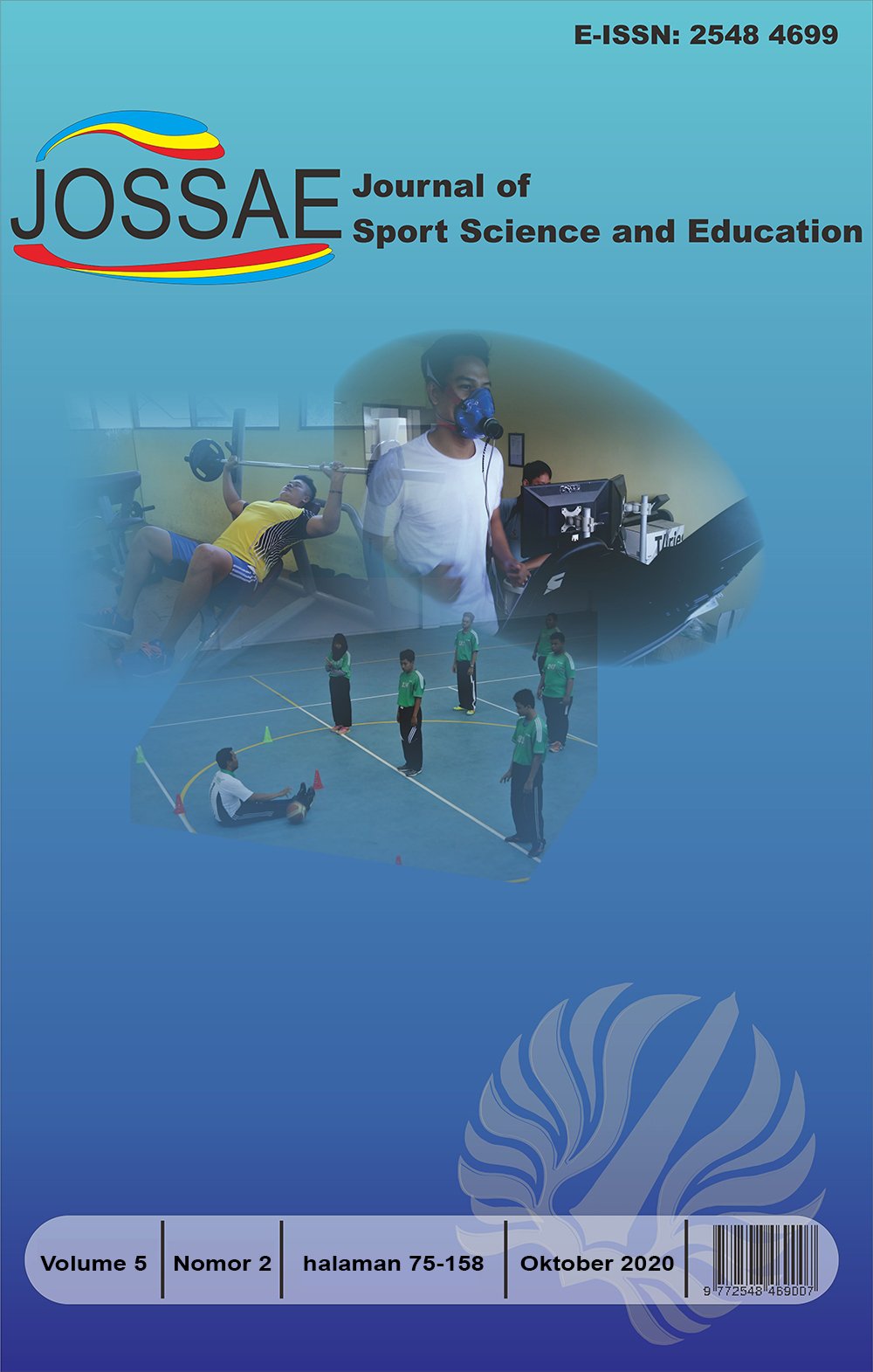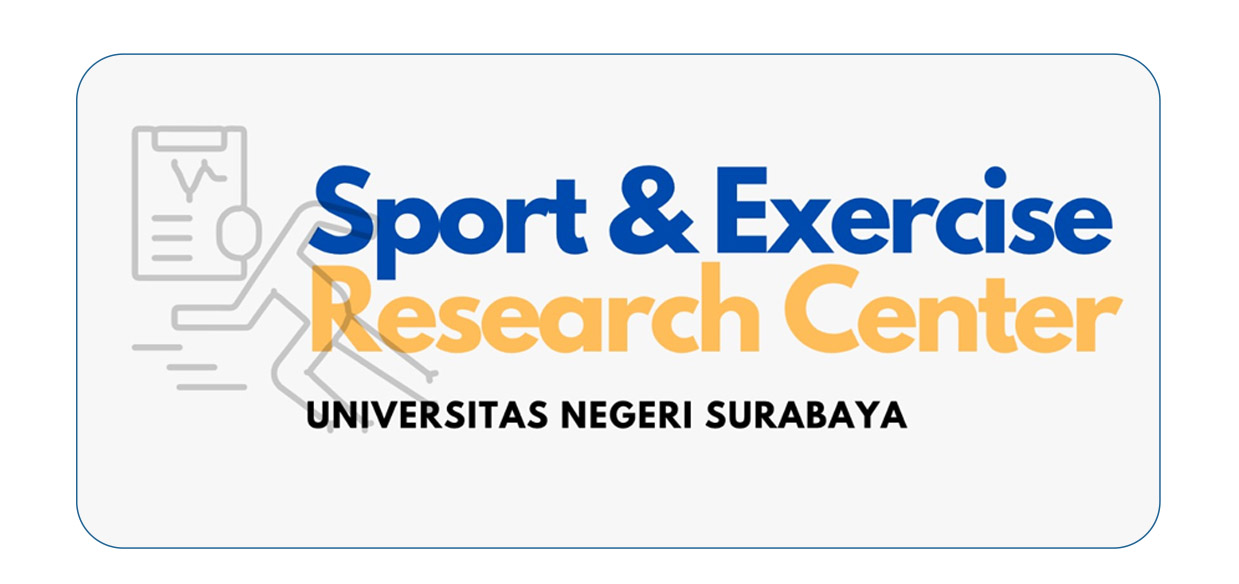Gambaran Risiko Terjadinya Gangguan Female Athlete Triad Syndrome pada Mahasiswi Olahraga
DOI:
https://doi.org/10.26740/jossae.v5n2.p104-115Keywords:
female athlete, energy availability, menstruation, bone densityAbstract
Abstrak
The contribution of women to the progress of national sports is evidenced through the contribution of achievement in world-class competitions. Achievements achieved certainly go through a training process that is not short-lived and health problems often occur as a consequence. This study aims to describe how much the risk of the occurrence Female Athlete Triad (FAT) Syndrome in sports students. This research uses a quantitative approach with survey data collection techniques. The research respondents were 60 active students from 2014-2019 Faculty of Sports Science, Semarang State University selected by quota sampling. The Instrument research use questionnaire that refers to the Female Athlete Triad: Cumulative Risk Assessment. The results showed the risk of impaired energy availability from a history of low frequency of eating 50% (n = 30), regulate body weight 41.7% (n = 25), specific lifestyle 40% (n = 24), fasting habits 60% (n = 36) and eating disorders 65% (n = 39). The risk of menstrual disorders of menarche delayed was 25% (n = 15), oligomenorrhea 50% (n = 30) and amenorrhea secondary 53.3% (n = 32). Risk of bone disorders 30% (n = 18). The description of the results of this study shows that the risk of sports college students suffering from FAT syndrome is quite large. The most surprising finding in this study was the low level of knowledge and information related to FAT syndrome among sports students. Given the large impact on health, necessary screening and further medical examinations as well as providing education about FAT syndrome disorders to female college students.
References
Brown, K. A., Dewoolkar, A. V., Baker, N., & Dodich, C. (2017). The female athlete triad: Special considerations for adolescent female athletes. Translational Pediatrics. https://doi.org/10.21037/tp.2017.04.04
Brown, K. N., Wengreen, H. J., & Beals, K. A. (2014). Knowledge of the female athlete triad, and prevalence of triad risk factors among female high school athletes and their coaches. Journal of Pediatric and Adolescent Gynecology. https://doi.org/10.1016/j.jpag.2013.11.014
Burke, L. M., Lundy, B., Fahrenholtz, I. L., & Melin, A. K. (2018). Pitfalls of conducting and interpreting estimates of energy availability in free-living athletes. International Journal of Sport Nutrition and Exercise Metabolism. https://doi.org/10.1123/ijsnem.2018-0142
De Souza, M. J., Toombs, R. J., Scheid, J. L., ODonnell, E., West, S. L., & Williams, N. I. (2010). High prevalence of subtle and severe menstrual disturbances in exercising women: Confirmation using daily hormone measures. Human Reproduction. https://doi.org/10.1093/humrep/dep411
De Souza, Mary Jane, Nattiv, A., Joy, E., Misra, M., Williams, N. I., Mallinson, R. J., ¦ Matheson, G. (2014). 2014 female athlete triad coalition consensus statement on treatment and return to play of the female athlete triad: 1st international conference held in San Francisco, CA, May 2012, and 2nd international conference held in Indianapolis, IN, May 2013. Clinical Journal of Sport Medicine. https://doi.org/10.1097/JSM.0000000000000085
Ducher, G., Turner, A. I., Kukuljan, S., Pantano, K. J., Carlson, J. L., Williams, N. I., & De Souza, M. J. (2011). Obstacles in the optimization of bone health outcomes in the female athlete triad. Sports Medicine. https://doi.org/10.2165/11588770-000000000-00000
Gharib, T., & Ackerman, K. (2012). (Athletic Training) Female Athlete Triad. Sports Health, 4(4), 302311. https://doi.org/10.1177/1941738112439685
Hoch, A. Z., Pajewski, N. M., Moraski, L., Carrera, G. F., Wilson, C. R., Hoffmann, R. G., ¦ Gutterman, D. D. (2009). Prevalence of the female athlete Triad in high school athletes and sedentary students. Clinical Journal of Sport Medicine. https://doi.org/10.1097/JSM.0b013e3181b8c136
House, S., Loud, K., & Shubkin, C. (2013). Female athlete triad for the primary care pediatrician. Current Opinion in Pediatrics. https://doi.org/10.1097/MOP.0000000000000033
KEMENPORA RI. (2012, June 26). Kita Bisa Rebut Emas Olimpiade¯! Retrieved from http://kemenpora.go.id/index/preview/berita/6008
KEMENPORA RI. (2016a). Menpora: Medali Perak Sri Wahyuni Harus Jadi Motivasi Atlet Indonesia yang Lain. Retrieved from http://www.kemenpora.go.id/index/preview/berita/10802
KEMENPORA RI. (2016b, June 26). Siaran Pers No. 23/Kom-Publik/Kemenpora/6:2016: Pemberian Bonus Bagi Atlet Asean Para Games dan Jaminan Hari Tua Bagi Peraih Medali Olimpiade. Retrieved from http://kemenpora.go.id/index/preview/pers/216
KEMENPORA RI. (2018, August 19). Menpora Harap Emas Pertama Defia Bisa Menular ke Atlet Indonesia yang Lain. Retrieved from http://www.kemenpora.go.id/index/preview/berita/12718
Kroshus, E., DeFreese, J. D., & Kerr, Z. Y. (2018). Collegiate athletic trainers knowledge of the female athlete triad and relative energy deficiency in sport. Journal of Athletic Training. https://doi.org/10.4085/1062-6050-52.11.29
Manore, M. M., Kam, L. C., & Loucks, A. B. (2007). The female athlete triad: components, nutrition issues, and health consequences... 2007 IAAF Consensus Conference on Nutrition for Athletics. Journal of Sports Sciences.
Matzkin, E., Curry, E. J., & Whitlock, K. (2015). Female Athlete Triad: Past, Present, and Future. Journal of the American Academy of Orthopaedic Surgeons. https://doi.org/10.5435/JAAOS-D-14-00168
Nattiv, A, Agostini, R., Drinkwater, B., & Yeager, K. K. (1994). The female athlete triad. The inter-relatedness of disordered eating, amenorrhea, and osteoporosis. Clinics in Sports Medicine. https://doi.org/10.1080/00098650209603960
Nattiv, Aurelia, Loucks, A. B., Manore, M. M., Sanborn, C. F., Sundgot-Borgen, J., & Warren, M. P. (2007). American College of Sports Medicine position stand. The Female Athlete Triad.
Medicine & Science in Sports & Exercise. https://doi.org/10.1249/mss.0b013e318149f111
Pantano, K. J. (2006). Current knowledge, perceptions, and interventions used by collegiate coaches in the u.s. Regarding the prevention and treatment of the female athlete triad. North American Journal of Sports Physical Therapy¯: NAJSPT, 1(4), 195207.
Pauli, S. A., & Berga, S. L. (2010). Athletic amenorrhea: Energy deficit or psychogenic challenge. Annals of the New York Academy of Sciences. https://doi.org/10.1111/j.1749-6632.2010.05663.x
Rauh, M. J., Nichols, J. F., & Barrack, M. T. (2010). Relationships among injury and disordered eating, menstrual dysfunction, and low bone mineral density in high school athletes: A prospective study. Journal of Athletic Training. https://doi.org/10.4085/1062-6050-45.3.243
Sherwood, L. (2016). Human physiology from cells to systems Ninth Edition. Appetite. https://doi.org/10.1016/j.appet.2008.10.006
Slater, J., Brown, R., McLay-Cooke, R., & Black, K. (2017). Low Energy Availability in Exercising Women: Historical Perspectives and Future Directions. Sports Medicine. https://doi.org/10.1007/s40279-016-0583-0
Tenforde, A. S., Sayres, L. C., McCurdy, M. L., Sainani, K. L., & Fredericson, M. (2013). Identifying sex-specific risk factors for stress fractures in adolescent runners. Medicine and Science in Sports and Exercise. https://doi.org/10.1249/MSS.0b013e3182963d75
Tosi, M., Maslyanskaya, S., Dodson, N. A., & Coupey, S. M. (2019). The Female Athlete Triad: A Comparison of Knowledge and Risk in Adolescent and Young Adult Figure Skaters, Dancers, and Runners. Journal of Pediatric and Adolescent Gynecology. https://doi.org/10.1016/j.jpag.2018.10.007
Warren, M. P., & Perlroth, N. E. (2001). The effects of intense exercise on the female reproductive system. Journal of Endocrinology. https://doi.org/10.1677/joe.0.1700003
Downloads
Published
How to Cite
Issue
Section
 Abstract views: 756
,
Abstract views: 756
, PDF Downloads: 793
PDF Downloads: 793









